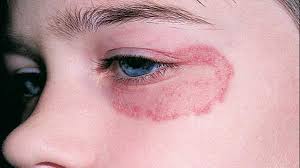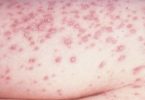What's in this article?
What is Ringworm?
Ringworm, also known as dermatophytosis or tinea, is a fungal infection of the skin. The name “ringworm” is a misnomer, since the infection is caused by a fungus, not a worm.
Ringworm infection can affect both humans and animals. The infection initially presents with red patches on affected areas of the skin and later spreads to other parts of the body. The infection may affect the skin of the scalp, feet, groin, beard, or other areas.
Ringworm facts
- Ringworm is a common fungal infection of the skin and is not due to a worm.
- The medical term for ringworm is tinea. The skin condition is further named for the site of the body where the infection occurs.
- Some types of ringworm infection include tinea corporis, tinea capitis, tinea pedis (“athlete’s foot”), and tinea cruris (“jock itch”).
- Ringworm causes a scaly, crusted rash that may appear as round, red patches on the skin. Other symptoms and signs of ringworm include patches of hair loss or scaling on the scalp, itching, and blister-like lesions.
- Ringworm is contagious and can be passed from person to person.
- Ringworm can be successfully treated with antifungal medications used either topically or orally.
Symptoms of Ringworm
The symptoms of ringworm include:
- a ring-like red or silvery rash on your skin – your skin will look red and irritated around the ring, but healthy inside
- scaly, itchy and inflamed skin
In more severe cases:
- the rings may multiply, grow in size and merge together
- the rings may feel slightly raised and the skin underneath may be itchy
- blisters and pus-filled sores may form around the rings
The ring spreads outwards as it progresses. You can have one patch or several patches of ringworm, and in more serious cases, your skin may become raised and blistered.
Causes of Ringworm
Ringworm is more common in unsanitary and crowded places. That’s because it can live on both skin and surfaces like shower floors, and can be transferred by sharing clothes, sheets, and towels. Even other mammals, including cats and dogs, can easily transfer ringworm to humans.
Types of Ringworm
Ringworm can go by different names depending on the part of the body affected.
- Ringworm of the scalp (tinea capitis) often starts as small sores that develop into itchy, scaly bald patches. It is most common among children.
- Ringworm of the body (tinea corporis) often appears as patches with the characteristic round “ring” shape.
- Jock itch (tinea cruris) refers to ringworm infection of the skin around the groin, inner thighs, and buttocks. It is most common in men and adolescent boys.
- Athlete’s foot (tinea pedis) is the common name for ringworm infection of the foot. It is frequently seen in people who go barefoot in public places where the infection can spread, such as locker rooms, showers, and swimming pools.
Risk Factors of Ringworm
As described previously, it is possible to acquire ringworm from a variety of places and circumstances. The greatest risk factor is coming in contact with an affected individual. Warm, moist areas are favorable conditions for the growth of fungi, so areas such as communal showers and locker rooms are areas in which transmission is favorable. However, any contact with an infected person or a contaminated surface can cause ringworm infection.
Treatments for Ringworm
Most tinea fungal infections, including ringworm, are easily treated by using antifungal creams, tablets or shampoo.
You can also help to get rid of fungal infections and stop them from spreading by:
- washing areas of affected skin daily and drying thoroughly, paying particular attention to skin folds and between your toes
- in the case of a groin/foot infection, changing your underwear/socks daily, because fungi can persist in flakes of skin
- with a scalp infection, not sharing combs, hairbrushes or hats
- washing clothes, towels and bed linen frequently
- wearing loose-fitting clothes, preferably made of cotton or other natural materials






Leave a Comment